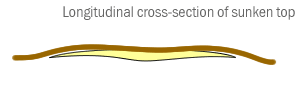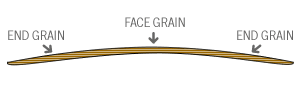|
|
|
|
|
|
LUTHIER
RANT
Fingerboards
| Bass Bars | Glues | Saddles
| Bridges
My Tuners | The
Sound Post | Regraduation
|
BASS BARS [continued] Any break in the overall structure will compromise it. You might ask what's the likelihood that an instrument would be under tension with one or more of its blocks loose. Every bass player I know [and probably every one you know] knows at least one older player who tells tales of when you could buy a Testore for $200 or a Landolfi for $500. There was a time when basses were the Rodney Dangerfields of the music world. No doubt virtually all the valued basses of our time spent at least part of their lives existing in horrendous conditions. It is likely that many would suffer deformities due to weakened structure. What of the notion that a properly sprung bar can push out a sunken top? Fig. 5 shows this scenario. It seems like this would work. But there are a few problems with this notion. To fit the bassbar to this top would require pulling the top to the bar in the fitting process, which would be extremely difficult. In addition the sinkage does not occur just under the bassbar, it occurs across the breadth of the top. Clamping the bar under these conditions would be extremely dangerous to the plate. Any responsible luthier would agree that arching corrections must be made in a mold before the bar can be fit. So let's say we've corrected the arch and we want to spring the bar to give the top "resistance." That would be nice, but it just doesn't work. Fig. 6 shows the grain cross-section of a top - this is true be it quartered or flat-sawn. The end grain exposed at the ends of the bar has structural strength depending on the arch but it has less grain strength than the longer face grain. What happens to the tension when the bar is glued in? As Mr. Weisshaar stated distortion occurs at the ends of the bar. How do I know this? I saw it happen scores of times. A top plate should be as close to perfectly flat as possible along the surface that glues to the ribs. The rib assembly should also be flat and parallel so that the top fits it exactly. When a bassbar is fit with spring this all goes out the window. The ends pull up and the top begins to be about as flat as a potato chip. Now it requires a great deal of effort to clamp the top to the ribs-in fact I've seen basses closed with so much tension that it required three strong men to do the job. That can't be right. Of course at that point the tension reverts back to the very ends of the bar and sinkage will occur around the ends of the bar. Some will say-Oh that's his opinion. Well, when does something change from being an opinion to being a fact. I guess it is just a matter of knowing. If I have to write an appraisal on a 250 year old bass - I might say "In my opinion this bass is a "so and so". But show me a Juzek or a Kay and I can say - That's a Juzek, that's a Kay. I know it! [Of course, my existential nature knows that nothing is truly knowable - wait, how can I know that?] So what I am proffering here is what I have come to know from my direct experience. In a shop I worked in I had the luxury of doing a fairly scientific experiment on bassbar spring. There were two basses in for exactly the same repair - sinkage and cracking under the lower end of the bassbar. The shop standard procedure was to correct the deformity with a mold, glue in a reinforcing veneer, and then glue in a sprung bassbar. One bass was English and I glued in a bar with no spring at all. The flat plane of the instrument was not distorted. The second bass was French and this one received a bar fit with the standard spring. This led to a clear distortion of the gluing edge. Once both these instruments were set up the English bass kept its healthy profile and the French bass sunk under the lower end of the bar. At least the cracks stayed closed, [epoxy'll do that.] The customer was not happy. |


| 359 Miller Avenue, Freeport, NY 11520 (516) 867 1395 · jbollbach17@gmail.com |
|
Fig. 5
Fig. 6
|

